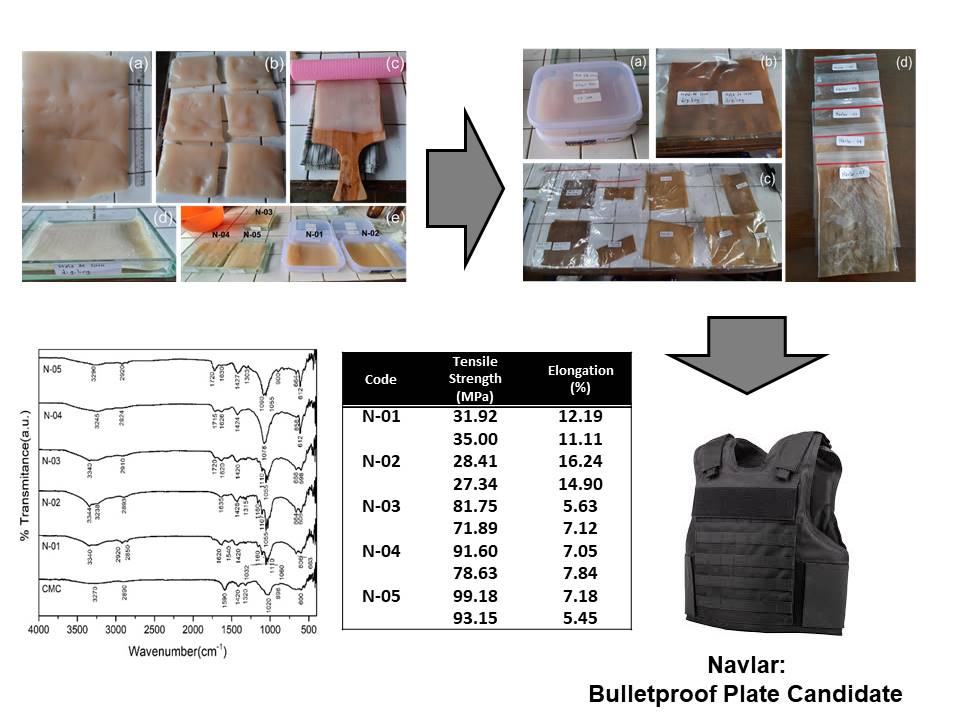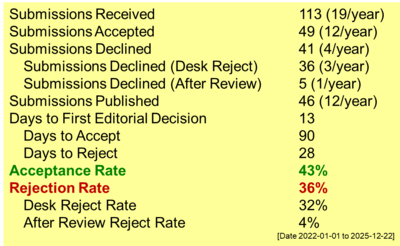Physical Strength Improvement of Nata de Coco by Water Replacement with Carboxymethylcellulose (CMC) as A Potential Bulletproof Material: A Preliminary Study
DOI:
https://doi.org/10.55749/ijcs.v1i2.19Keywords:
Bulletproof material, CMC, Kevlar plate, Nata de CocoAbstract
The dependence on the imported bullet-proof vest as one of the main equipments of the National Defense System needs attention. This condition treats the independence of domestic defense security. In contrast, the potential of natural materials for bullet-proof vest plates are abundant in Indonesia. Nata de Coco is one of the natural raw materials for producing bullet-proof vest plates that has the potential to be developed. This preliminary research proved that increasing the bond strength of cellulose in Nata de Coco was performed by adding the appropriate crosslinkers. The addition of carboxymethylcellulose (CMC) 2% crosslinker to form Nata de Coco kevlar-like plates (Navlar) was evidenced to increase threefold tensile strength (99.15 MPa) from its original Nata de Coco (31.92 MPa). The development of Navlar is a very strategic sector for producing high-quality bullet-proof vest plates equivalent to kevlar strength. Navlar is more prospective than Kevlar due to its abundant source, cheap, lightweight, and ease to manufacture. Developing Navlar could replace the dependence on imported Kevlar and support the domestic defense industry.
References
Nurazzi, N.M., Asyraf, M.R.M., Khalina, A., Abdullah, N., Aisyah, H.A., Rafiqah, S.A., Sabaruddin, F.A., Kamarudin, S.H., Norrrahim, M.N.F., Ilyas, R.A., Sapuan, S.M. 2021. A review on natural fiber reinforced polymer composite for bullet proof and ballistic applications. Polymers. 13(4). 1-42. doi: 10.3390/polym13040646. https://doi.org/10.3390/polym13040646
Azmi, A.M.R., Sultan, M.T.H., Jawaid, M., & Nor, A.F.M. 2019. A newly developed bulletproof vest using kenaf-X-ray film hybrid composites, in Mechanical and Physical Testing of Biocomposites, Fibre-Reinforced Composites and Hybrid Composites. 157-169. doi: 10.1016/B978-0-08-102292-4.00009-6. https://doi.org/10.1016/B978-0-08-102292-4.00009-6
Muthalagu, R., Murugesan, J., Sathees Kumar, & Sridhar Babu. 2021. Tensile attributes and material analysis of kevlar and date palm fibers reinforced epoxy composites for automotive bumper applications. Mater. Today Proc. 46. 433-438. doi: 10.1016/j.matpr.2020.09.777. https://doi.org/10.1016/j.matpr.2020.09.777
Sarwar, A., Bougherara, H., & Zdero, R. 2022. Tensile and compressive damage assessment of a novel sandwich composite structure made of Kevlar/flax/epoxy hybrid laminates. Proc. Inst. Mech. Eng. Part L J. Mater. Des. Appl. 236(9). 1842-1853. doi: 10.1177/14644207221085686. https://doi.org/10.1177/14644207221085686
Conte, G., Stelitanoa, S., Policicchio, A., Minuto, F.D., Lazzaroli, V., Galiano, F., & Agostino, G.R. 2020. Assessment of activated carbon fibers from commercial Kevlar® as nanostructured material for gas storage: Effect of activation procedure and adsorption of CO2 and CH4. J. Anal. Appl. Pyrolysis. 152. 104974. doi: 10.1016/j.jaap.2020.104974. https://doi.org/10.1016/j.jaap.2020.104974
Juntaro, J., Ummartyotin, S., Sain, M., & Manuspiya, H. 2012. Bacterial cellulose reinforced polyurethane-based resin nanocomposite: A study of how ethanol and processing pressure affect physical, mechanical and dielectric properties. Carbohydr. Polym. 87(4). 2464-2469. doi: 10.1016/j.carbpol.2011.11.020. https://doi.org/10.1016/j.carbpol.2011.11.020
Ismojo, Hafizh, R., & Suastiyanti, D. 2020. Study Perbandingan Serat Jute Jawa Dengan Kevlar Sebagai Penguat Epoxy Untuk Aplikasi Helm Anti Peluru Berdasarkan Analisa Numerik. J. Tek. Mesin ITI. 4(2). 37-45. doi: 10.31543/jtm.v4i2.400. https://doi.org/10.31543/jtm.v4i2.400
Firman, S.H., Muris, & Subaer. 2015. Studi Sifat Mekanik dan Morfologi Komposit Serat Daun Nanas- Epoxy Ditinjau dari Draksi Fassa dengan Orientasi Serat Acak. J. Sains dan Pendidik. Fis. 11(2). 185-191. doi: 10.35580/jspf.v11i2.1487. https://doi.org/10.35580/jspf.v11i2.1487
Gabr, M.H., Elrahman, M.A., Okubo, K., & Fujii, T. 2010. A study on mechanical properties of bacterial cellulose/epoxy reinforced by plain woven carbon fiber modified with liquid rubber, Compos. - A: Appl. Sci. Manuf. 41(9), 1263-1271. doi: 10.1016/j.compositesa.2010.05.010. https://doi.org/10.1016/j.compositesa.2010.05.010
Vu, C.M., Nguyen, D.D., Sinh, L.H., Pham, T.D., Pham, L.T., & Choi, H.J. 2017. Environmentally benign green composites based on epoxy resin/bacterial cellulose reinforced glass fiber: Fabrication and mechanical characteristics. Polym. Test. 61. 150-161. doi: 10.1016/j.polymertesting.2017.05.013. https://doi.org/10.1016/j.polymertesting.2017.05.013
Chunshom, N., Chuysinuan, P., Techasakul, S., & Ummartyotin, S. 2018. Dried-state bacterial cellulose (Acetobacter xylinum) and polyvinyl-alcohol-based hydrogel: An approach to a personal care material. J. Sci. Adv. Mater. Devices. 3(3). 296-302. doi: 10.1016/j.jsamd.2018.06.004. https://doi.org/10.1016/j.jsamd.2018.06.004
Mulyawan, A.S., Sana, A.W., & Kaelani, Z. 2015. Identifikasi Sifat Fisik Dan Sifat Termal Serat-Serat Selulosa Untuk Pembuatan Komposit. Arena Tekst. 30(2). 75-82. doi: 10.31266/at.v30i2.1955. https://doi.org/10.31266/at.v30i2.1955
Kristanti, A. N., Aaminah, N. S., Wafiroh, S., Sudiro, D., & Setiaji, B. 2010. Effort To Utilize Nata De Coco As Bullet-Proof Material. 2nd Int. Conf. Chem. Sci. Proc. (1410). 371-373.
Zehra, B., Solangi, B.A., & Nadeem, U. 2022. Preparation of Flame Resistant Retanning Product for Glove Leather. Indones. J. Chem. Stud. 1(2). 39-42. doi:10.55749/ijcs.v1i2.11. https://doi.org/10.55749/ijcs.v1i2.11
Li, X., Tang, Z., Sun, Z., Simonsen, J., Luo, Z., Li, X., & Morrell, J.J. 2022. Chemical and Enzymatic Fiber Modification to Enhance the Mechanical Properties of CMC Composite Films. Polymers. 14(19). 1-14. doi: 10.3390/polym14194127. https://doi.org/10.3390/polym14194127
Sekine, Y., Nankawa, T., Yunoki, S., Sugita, T., Nakagawa, H., & Yamada, T. 2020. Eco-friendly Carboxymethyl Cellulose Nanofiber Hydrogels Prepared via Freeze Cross-Linking and Their Applications. ACS Appl. Polym. Mater. 2(12). 5482-5491. doi: 10.1021/acsapm.0c00831. https://doi.org/10.1021/acsapm.0c00831
Benzait, Z. & Trabzon, L. 2018. A review of recent research on materials used in polymer-matrix composites for body armor application. J. Compos. Mater. 52(23). 3241-3263. doi: 10.1177/0021998318764002. https://doi.org/10.1177/0021998318764002

Downloads
Published
How to Cite
Issue
Section
License
Copyright (c) 2022 Indonesian Journal of Chemical Studies

This work is licensed under a Creative Commons Attribution-ShareAlike 4.0 International License.






















